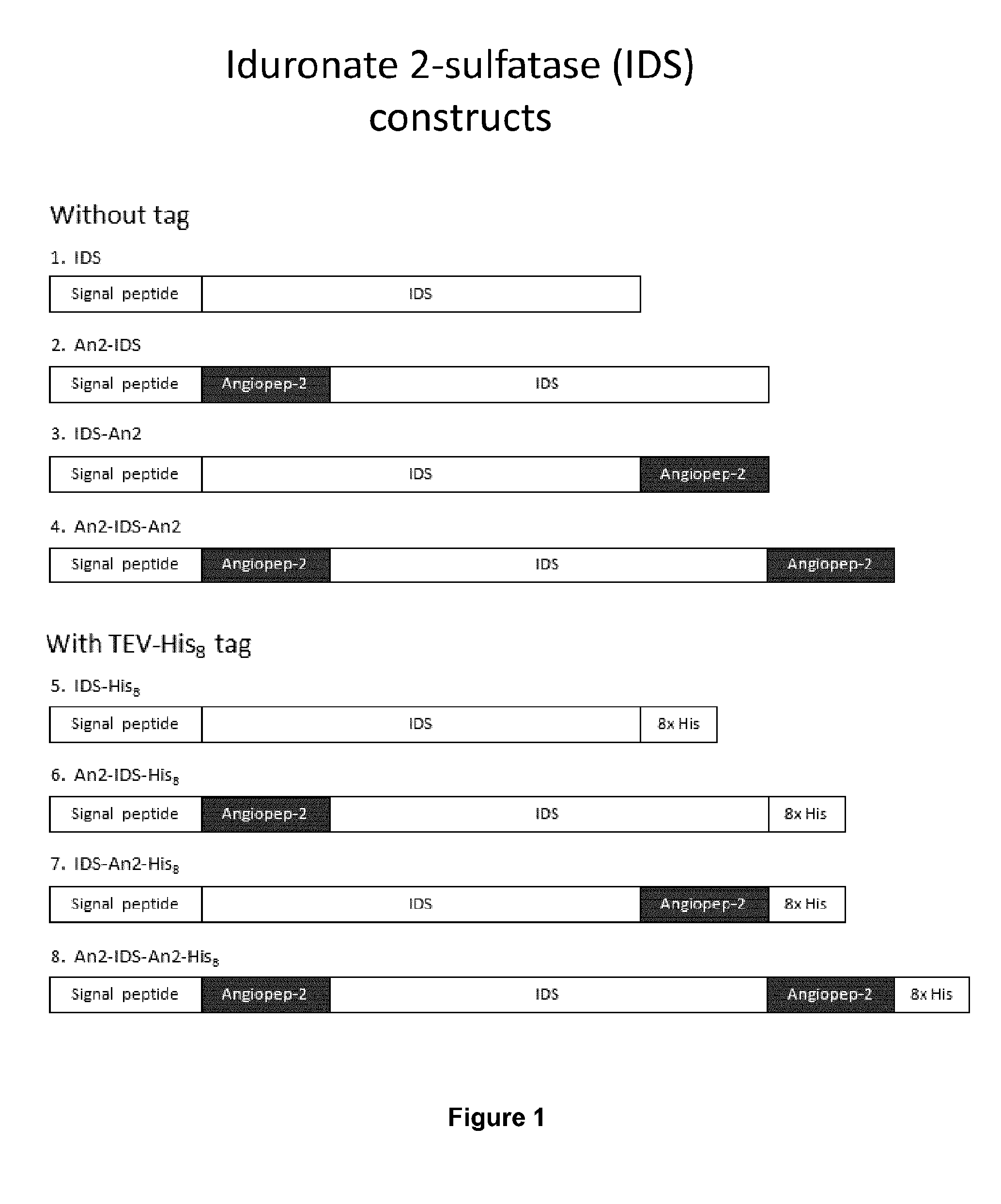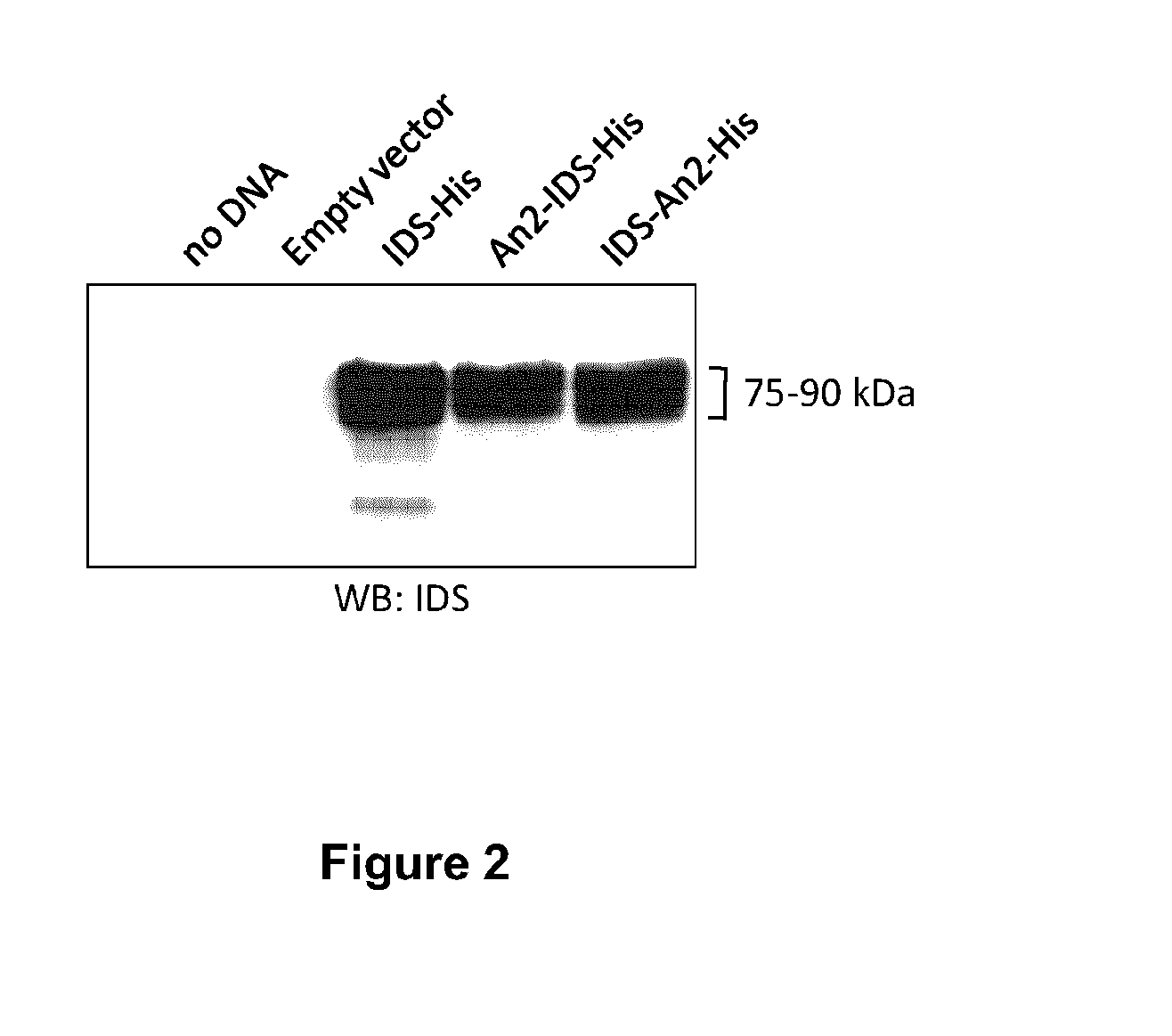Targeted lysosomal enzyme compounds
- Summary
- Abstract
- Description
- Claims
- Application Information
AI Technical Summary
Benefits of technology
Problems solved by technology
Method used
Image
Examples
example 1
Design of IDS-Angiopep-2 Fusion Proteins
[0190]A series of IDS-Angiopep-2 constructs were designed. The IDS cDNA was obtained from Origene (Cat. No. RC219187). Three basic configurations were used: an N-terminal fusion (An2-IDS and An2-IDS-His), a C-terminal fusion (IDS-An2 and IDS-An2-His), and an N- and C-terminal fusion (An2-IDS-An2 and An2-IDS-An2-His), both with and without an 8×His tag (FIG. 1). A control without Angiopep-2 was also generated (IDS and IDS-His).
example 2
Expression and Activity of Recombinant hIDS Proteins in CHO—S Cells
[0191]These constructs were then expressed in CHO—S cells grown in suspension. IDS constructs were expressed by transient transfection in FreeStyle CHO—S cells (Invitrogen), using linear 25 kDa polyethyleneimine (PEI, Polyscience) as the transfection reagent. In one example, DNA (1 mg) was mixed with 70 ml FreeStyle CHO Expression medium (Invitrogen) and incubated at room temperature for 15 min PEI (2 mg) was separately incubated in 70 ml medium for 15 minutes, and then DNA and PEI solutions were mixed and further incubated for 15 min. The DNA / PEI complex mixture was added to 360 ml of medium containing 1×109 CHO—S cells. After a four-hour incubation at 37° C., 8% CO2 with moderate agitation, 500 ml of warm medium was added. CHO—S cells were further incubated for 5 days in the same conditions before harvesting.
[0192]To determine if the cells were expressing and secreting IDS or an IDS fusion protein, a western blot u...
example 3
Characterization and Optimization of Expression
[0196]To further characterize expression, time course evaluation of IDS expression and activity in CHO—S cells grown in suspension was measured for the IDS-His and IDS-An2-His fusion proteins as shown in FIG. 5A and FIG. 5B. From these data, maximal IDS expression and activity was observed five days after transfection. No recapture of IDS-An2-His by CHO—S cells was observed in these experiments.
[0197]To further optimize transfection conditions, transfection was performed using two different numbers of cells (1.25×107 cells or 2.5×107 cells). Three different ratios of DNA to polyethylenimine (PEI) were used (1:1, 1:2, 1:3, and 1:4).
[0198]From these experiments, the best results were obtained using a 1:2 DNA:PEI ratio, as shown by the IDS activity (FIG. 5A) and by expression analysis (FIG. 5B).
PUM
| Property | Measurement | Unit |
|---|---|---|
| Fraction | aaaaa | aaaaa |
| Structure | aaaaa | aaaaa |
| Covalent bond | aaaaa | aaaaa |
Abstract
Description
Claims
Application Information
 Login to View More
Login to View More - R&D
- Intellectual Property
- Life Sciences
- Materials
- Tech Scout
- Unparalleled Data Quality
- Higher Quality Content
- 60% Fewer Hallucinations
Browse by: Latest US Patents, China's latest patents, Technical Efficacy Thesaurus, Application Domain, Technology Topic, Popular Technical Reports.
© 2025 PatSnap. All rights reserved.Legal|Privacy policy|Modern Slavery Act Transparency Statement|Sitemap|About US| Contact US: help@patsnap.com



